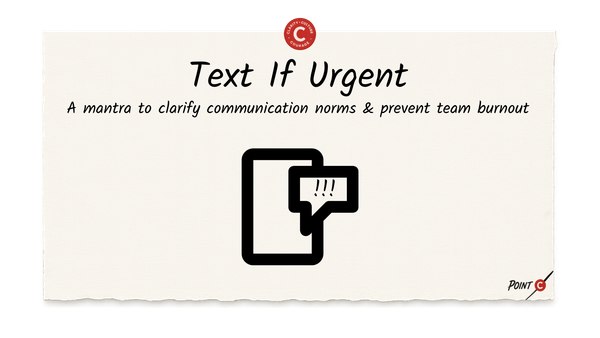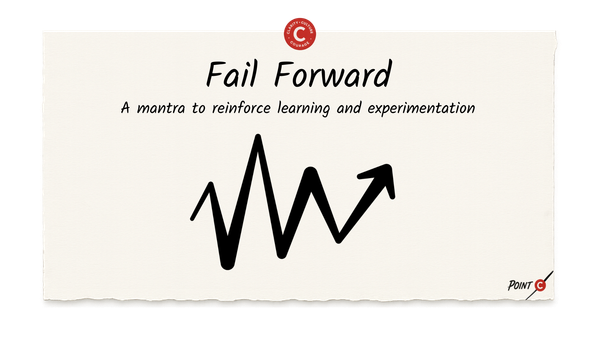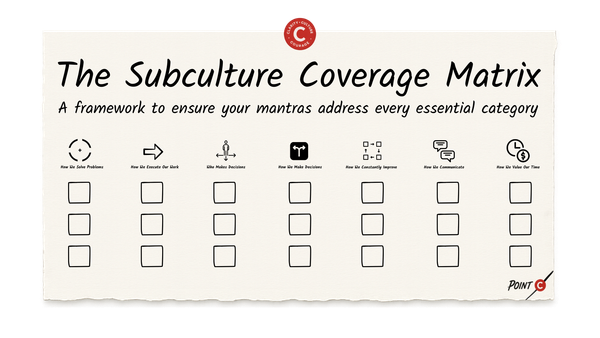Be Human-Centered
A mantra to keep us coming back to the user to guide our work

Happy Thanksgiving!
I'm grateful for your support this year as I launched Point C. And I'm especially thankful that you have committed to becoming a more intentional leader — building a subculture that unlocks the full potential of everyone on your team. I’m sure they’re grateful, too.
Lately in The Idea Bucket, we’ve been exploring one leadership mantra from each of the seven essential categories of the Subculture Coverage Matrix:
- How We Solve Problems
- How We Execute Our Work (Fail Forward)
- Who Makes Decisions (One Consultative Decision Maker Per Lane)
- How We Make Decisions (Always Separate Flaring & Focusing)
- How We Constantly Improve (Feedback is a Gift - Not a Demand)
- How We Communicate (Text If Urgent)
- How We Value Our Time (Honor The Maker's Schedule)
Today, we'll explore my fundamental mantra in How We Solve Problems: Be Human-Centered
It’s a mantra that ensures your team keeps returning to the user to guide their work — a critical shift from ideas-first to needs-first thinking.
The Foundation of Design Thinking
Almost 20 years ago, I had the privilege of being a student and then a fellow at the Stanford d.school back when it was first getting off the ground. Being able to join the team building the d.school in its early days was one of my most formative experiences when it comes to building a subculture of innovation.
What I learned from David Kelley and others who had been perfecting the practice was that design thinking is both a creative process and a collection of mindsets for approaching that process. It’s a process you can follow step-by-step — to build something from scratch or improve what already exists. Being mindful of process enables innovators to know what to do next even in the face of ambiguity. Once you've gotten the hang of the step-by-step process, you can begin to be a little more fluid in your creative approach as long as you are guided by certain core design thinking mindsets. The two most foundational design thinking mindsets are:
- Be Human-Centered: Always come back to the user to guide your work from initial empathy work, to defining a point-or-view, to co-creation, to testing and iterating.
- Be Prototype-Driven: Embrace imperfection by building and testing rough prototypes early and often so that you can fail forward.
Today we'll explore what it means to Be Human-Centered and next week we'll explore how to Be Prototype-Driven.
Why Idea-First Is Flawed
When it comes to innovation, most of us start in the wrong place: my brilliant idea!
We come up with an idea - a specific product, service, or creation - and we anchor the entire effort going forward around that idea. This is an ideas-driven approach - and it's fundamentally flawed. It grounds a project in a specific solution (a noun) rather than the specific user problem (a verb connected to a person and a context) you should be trying to solve in the first place. Starting with a solution oftentimes results in not properly defining the problem to be solved. And it limits the breadth of innovative solutions that might be possible.
The mantra Be Human-Centered breaks this cycle. It pushes your team to keep coming back to the user to guide their work. Instead of being Ideas-Driven they become Needs-Focused and Solution-Agnostic. If they do start with an idea (which is OK because ideas come at all different times), they treat it as a hypothesis — not a commitment — and return to the user need fast. They know that idea belongs in The Idea Bucket — not at the center of the project.
What Human-Centered Really Looks Like
In an organization that holds Be Human-Centered as a core mantra, the user provides fuel and guidance at every stage of the process:
- Empathy - During the initial user research phase of a project, the visceral experience of qualitative user research provides the creative fuel necessary to spark and inspire the team.
- Define - The synthesis of user research and the crafting of a point-of-view statement provides the focus for the problem to be solved.
- Ideation - The user research and definition provides the creative fuel to imagine multiple solutions to the problem.
- Prototype - Designing for a specific user prevents a solution that tries to be all things to all people. And co-creating with a user unlocks new possibilities and insights.
- Test - Everything comes back to the user for evaluation. Your team begins to operate with a Let The User Decide mentality.
- Storytelling - A clear user focus unlocks character-driven narratives about the user journey and your vision for it. You move from bullet points to narratives.
When you embrace the mantra Be Human-Centered, you signal to your team that the user should be a part of every discussion. Often, the first practical shift I see after a client attends one of my training camps is in the questions they start asking in meetings: Who is this for?
Once you see the power of being human-centered, you can’t unsee the gaps when it’s missing.
Your Challenge This Week
Practice spotting human-centered thinking in action — and where it’s missing.
In every meeting you attend:
- Listen for a clearly defined user need.
- If you don’t hear it, ask: Who is this for?
- Evaluate how well the answer centers the user.
- At week’s end, reflect on what you noticed.
- Share your observations in your next team meeting. Use the words: Be Human-Centered.
Next Week
We've now covered one mantra in each of the seven essential categories:
- How We Solve Problems (Be Human-Centered)
- How We Execute Our Work (Fail Forward)
- Who Makes Decisions (One Consultative Decision Maker Per Lane)
- How We Make Decisions (Always Separate Flaring & Focusing)
- How We Constantly Improve (Feedback is a Gift - Not a Demand)
- How We Communicate (Text If Urgent)
- How We Value Our Time (Honor The Maker's Schedule)
Next week, we'll explore the second fundamental mindset of design thinking: Be Prototype-Driven.
About This Newsletter
The Idea Bucket is a weekly newsletter and archive featuring one visual framework, supporting one act of leadership, that brings you one step closer to building a culture of innovation.
It’s written by Corey Ford — executive coach, strategic advisor, and founder of Point C, where he helps founders, CEOs, and executives clarify their visions, lead cultures of innovation, and navigate their next leadership chapters.
Want 1:1 executive coaching on this framework or others? Book your first coaching session. It's on me.




